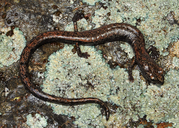|
Batrachoseps bramei Jockusch, Martínez-Solano, Hansen & Wake, 2012
Fairview Slender Salamander Subgenus: Batrachoseps | family: Plethodontidae subfamily: Hemidactyliinae genus: Batrachoseps |
| Species Description: Jockusch EL, Martinez-Solano I, Hansen RW, Wake DB. 2012 Molecular and morphological diversification of slender salamanders (Caudata: Plethodontidae: Batrachoseps) in the southern Sierra Nevada with descriptions of two new species. Zootaxa 3190:1-30 | |
 © 2012 Robert W. Hansen (1 of 11) |
|
|
|
Description B. bramei can be distinguished from other members of the B. nigriventis group by its robust appearance (more robust than B. simatus, less robust than B. stebbinsi), small size, broad head, long limbs, and relatively large hands and feet (Jockusch et al. 2012). Coloration: The base coloration of the dorsum in B. bramei is slate black or brown black. The ventral surfaces are uniformly black. The iris is gray. Guanophores on the dorsum and on the lateral surfaces result in a metallic silver or brassy appearance (Jockusch et al. 2012). Variation: There are differences between the sexes in terms of size and number of teeth (with females generally being larger and having more teeth). Males have enlarged premaxillary teeth relative to their maxillaries. Males from more southern populations are larger than those from northern populations. Chest width is narrower in individuals from the Cannel Creek area than in individuals from the type locality. Less webbing is present in specimens from Wofford Heights. Color in B. bramei varies significantly both within populations and across its range. Some individuals may have gold or copper colored patches over their shoulders, distinct from their dorsolateral stripes. Individuals in the northern parts of the range generally have dull dorsal coloration, but bold red or metallic coloration can be seen in individuals near Cannell Creek (Jockusch et al. 2012). Distribution and Habitat Country distribution from AmphibiaWeb's database: United States U.S. state distribution from AmphibiaWeb's database: California
B. bramei are often found beneath rocks, logs, leaf litter, or other cover in a chaparral plant community. They are often associated with talus at the base of slopes (Jockusch et al. 2012). Trends and Threats Possible reasons for amphibian decline General habitat alteration and loss Comments B. bramei is named for Arden H. Brame, Jr., who was the first (along with Keith Murray) to recognize Kern River Canyon Batrachoseps as morphologically distinct from other Slender Salamanders in California (Jockusch et al. 2012). Brame and Murray (1968) labelled B. bramei specimens "B. simatus," but noted their distinct morphology.
References
Jockusch, E.L., Martínez-Solano, I., Hansen, R.W., Wake, D.B. (2012). ''Morphological and molecular diversification of slender salamanders (Caudata: Plethodontidae: Batrachoseps) in the southern Sierra Nevada of California with descriptions of two new species.'' Zootaxa, 3190, 1-30. Originally submitted by: John Cavagnaro (first posted 2012-09-17) Edited by: Michelle S. Koo (2012-10-04) Species Account Citation: AmphibiaWeb 2012 Batrachoseps bramei: Fairview Slender Salamander <https://amphibiaweb.org/species/7771> University of California, Berkeley, CA, USA. Accessed Jul 26, 2024.
Feedback or comments about this page.
Citation: AmphibiaWeb. 2024. <https://amphibiaweb.org> University of California, Berkeley, CA, USA. Accessed 26 Jul 2024. AmphibiaWeb's policy on data use. |



 Raffaëlli Account
Raffaëlli Account Map of Life
Map of Life